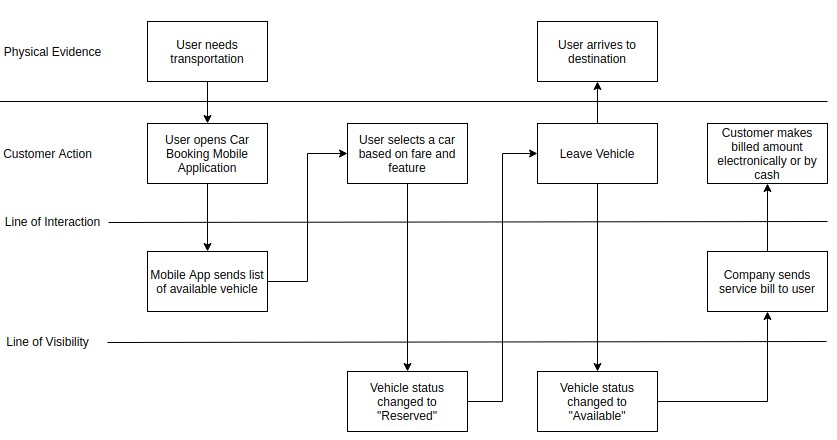5 Star Rating
Orders Deliver
PhD Experts
Support
Privacy
Top Quality
Number Of View : 2096
Download : 0
Pages: 3
Words : 742
This assignment challenges your ability to identify, capture, sequence, and align process activities in a way that enables clear communication of the process and visibility to all activities, including those that are unseen by the customer. Create a manufacturing or service blueprint that depicts a product or service offering for your company. You may use another corporation if your company does not manufacture a product or provide a service. Your blueprint should capture the process, which begins from the start of the purchase and ends with completion/delivery.
Introduction
In this paper a service blueprint of a car rental company has been presented with a brief description. Further, two procedures have been discussed that block or prevent mistakes in the hospitality service process.

Service Blueprint
The diagram below shows the service blueprint of the company providing transport service to the customers:
In the above service blueprint it can be seen that there are several stages through which a process is undertaken. At first, the customer feels the need for the transportation. At this stage, the customer opens the mobile application of the company. After the mobile application, the mobile detects the location of the user and sends it to the company server. Mobile app sends a list of available vehicles in the area to the screen of the customers. The customer can see all the cars on the screen displaying on the small map. The customer also sees the various prices at which cars of different features are available. The customer picks a car of his choice and locks the option by confirming. After the confirmation, the status of the car gets locked and it changes from “available” to “reserved”, and is not available for other customers to rent. After that the customer rides the car, the car leaves the customer at the designated spot and then the customer leaves the car. After the customer leaves the car at the defined location, the status of the car is changed to “available”. After that the system generates total bill for the customer and shows in the mobile application. The customer makes electronic payment through the mobile application or makes cash payment to the car driver.
Mistake proofing process enhancements
Poka Yoke or mistake proofing is used by the businesses to ensure that the mistakes that can be avoided are prevented by placing appropriate checks (Saurin et al, 2012; Shahin & Ghasemaghaei, 2010). Given below are the two procedures that can be used by the hospitality service process to reduce the mistakes:
Queue management systems can be one method to ensure that the mistakes are not made. As for example, in the banking sector if the customers are served at random instead of who came first basis, then there is likely to be chaos in the bank. Therefore, in order to have a smooth processing of the activities, the bank can ensure that the customers are served on the first come first serve basis. Moreover the customers are served as and when they reach the bank instead of making them wait for longer as it will lead to the crowd at the banks. The bank can use electronic methods to handle this process, such as providing tokens to the customers (Ghazal et al, 2015; Xiao & Zhang, 2010).
Another method that can be used in the service process is tying up the service request by the customers to them with a unique identifier. As for example, in restaurants, waiters can use electronic waiter pads and tie it with table number to ensure that no order mismatch takes place and all the orders are requested from the cook electronically. Moreover, delivery of the order by the waiter should end up with confirmation button on the electronic pad that indicates successful delivery (Cho, 2015).
References
Saurin, T. A., Ribeiro, J. L. D., & Vidor, G. (2012). A framework for assessing poka-yoke devices. Journal of manufacturing systems, 31(3), 358-366.
Shahin, A., & Ghasemaghaei, M. (2010). Service poka yoke. International Journal of Marketing Studies, 2(2), 190.
Ghazal, M., Hamouda, R., & Ali, S. (2015, October). An iot smart queue management system with real-time queue tracking. In 2015 Fifth International Conference on e-Learning (econf) (pp. 257-262). IEEE.
Cho, B. (2015). Design of restaurant advertisement and order system using bluetooth 4.0 technology. The Journal of The Institute of Internet, Broadcasting and Communication, 15(1), 69-76.
Xiao, H., & Zhang, G. (2010). The queuing theory application in bank service optimization. In 2010 International Conference on Logistics Systems and Intelligent Management (ICLSIM) (Vol. 2, pp. 1097-1100). IEEE.
Limitless Amendments
$09.50 free
Bibliography
$10.50 free
Outline
$05.00 free
Title page
$07.50 free
Formatting
$07.50 free
Plagiarism Report
$10.00 free
Get all these features for $50.00
Enter your email, and we shall get back to you in an hour.